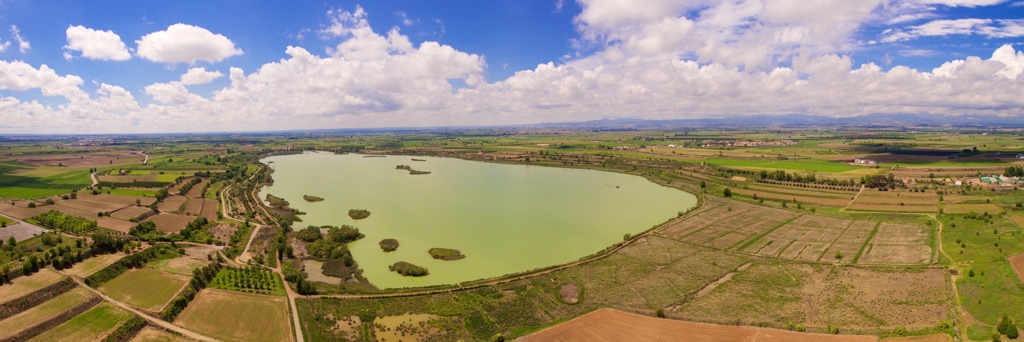The combination of water, flora, fauna and landscape goes together to create an amazing pond in the middle of the Urgell plain. Marsh, riparian, and dryland vegetation, as well as that of the surrounding fields, has favoured the natural colonization of fauna, with species such as otters, western marsh harriers, bearded reedlings, or European pond turtles, among many others.
This is one of the most important wetland areas in inland Catalonia. The biological richness that it hosts is important for diversity and for the conservation of many species.
The reed is an aquatic plant that is found in flooded soils or on the edges of rivers and ponds. It can be found throughout the perimeter and mainly on the eastern side, where it forms a sewage treatment reed bed. On precisely this side, semi wild horses can be found to graze as a way of encouraging biodiversity in the area.
Riparian, silver poplar, ash, poplar, alder, elm, white willow and tamarisk forests can also be found. The riparian forest is highly diverse in terms of flora and is a key place of refuge, breeding and feeding for many species of fauna wanting to go unnoticed.
Despite the general levelness of the area, there are some small hills.
FLORA AND VEGETATION
Within the protected area of the Estany d'Ivars i Vila-sana over 400 plant species have been identified.
To be found within these communities are the following:
- Submerged macrophytes and some floating plants such as duckweed.
- Helophites, such as the reed and the cattail.
- Riparian forest with silver poplar, ash, poplar, tamarisk, elm, alder and white willow.
- Kermes oak and black hawthorn maquis that derive from precursory plantations created in some sectors further away from the water, such as Mediterranean buckthorn, gorse, kermes oak and holm oak.
- Nitrophilous and ruderal grasses which grow at the dry stone walls of fields, such as ryegrass, poppies, velvetleaf or milk thistle.
- And, occasionally, other interesting species in this context can be found, such as the grasses brachypodium, albardine, spear grass; nitrohalophilic vegetation formed mainly by a scrubland of Mediterranean saltwort, white wormwood, populations of prostrate Canary clover and halophilic vegetation represented by prickly saltwort, sea lavender and sea heath.
WILDLIFE
When converted into numbers the wildlife of the Estany d'Ivars i Vila-sana includes 250 species of birds, 31 species of mammals, 6 species of reptiles, 5 species of amphibians, 7 species of fish and about 21 species of odonates. However, there is still surely much to know and discover, especially regarding invertebrates.
The most common species of mammal is the otter, which has colonized the lake probably by way of the river Corb from the river Segre. But a series of bat species also stands out, with a least 10 different species detected. On the other hand, it is worth mentioning the common species in dry stone walls and fields, such as the fox, wild boar, badger, rabbit or small mammals, such as shrews, mice and rats.
Regarding reptiles, the two autochthonous aquatic turtles - the Spanish pond turtle and European pond turtle - can be seen in the pond, but unfortunately an American turtle, about which measures have been taken to control its prevalence, also populates the pond. Also residing in its waters is the viperine water snake, which tries to escape the sight of the herons and egrets.
Amphibians, frogs and toads, such as the Perez's frog and the common midwife toad, are found everywhere, especially in pools or water points near the pond where they shelter from possible predators, such as fish and birds.
Among the fish, alien and invasive populations such as the carp and zander dominate. Coexistence with native or potential species, such as the barb, and the South-west European nase, is difficult if populations are not controlled. On the other hand, the eel, which was very abundant in the old pond, requires the removal of barriers or steps to traverse the dams of the reservoirs on the river Ebro.
BIRDS (ORNITHOLOGY)
One of the pond's main attractions is birds watching. A very nice time's to be had with the help of binoculars, some peace and quite and a guidebook to birds. Aquatic birds abound in the pond as they depend on it for their survival, for food, refuge or nesting. They are usually morphologically and functionally adapted to moving around in water, swimming, diving or walking in floodplains. It should be taken into account that the bird populations that can be observed vary throughout the year depending on whether it is a species that is wintering, summer visitor, breeding, migratory or sedentary.
The most prevalent groups and species in the pond are:
- Egrets and stilts: storks, grey herons, herons and cattle egrets.
- Waders: black-winged stilts, common snipes, lapwings, sandpipers, redshanks, godwits and plovers.
- Swimmers: ducks, coots, cormorants, grebes and moorhens.
- Gulls and terns: European herring gull, black-headed gull, and black tern.
- Birds of prey: western marsh harriers, common buzzards, kites, falcons and sparrow hawks.
- Small birds: swallows, tits, warblers, chiffchaffs, great reed warblers and common reed buntings.
- Other groups of birds: hoopoes, kingfishers, cuckoos, owls, swifts, pigeons.
